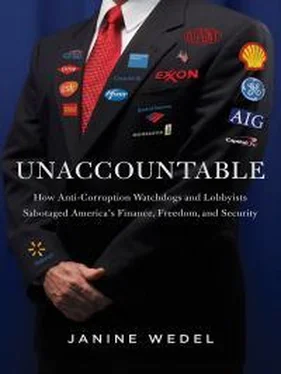In Russia, voucher privatization fostered the concentration of vouchers and property in a few hands (through unregulated voucher investment funds, for instance); managers retained control over most industries, and investors wound up owning very little (Hilary Appel, “Voucher privatisation in Russia: structural consequences and mass response in the second period of reform.” Europe-Asia Studies, vol. 49, no. 8, pp. 1433-1449; Lynn D. Nelson and Irina Y. Kuzes, Property to the People: The Struggle for Radical Economic Reform in Russia . Armonk, NY: M. E. Sharpe, 1994, pp. 25-26; Janine R. Wedel, Shadow Elite: How the World’s New Power Brokers Undermine Government, Democracy, and the Free Market . New York: Basic Books, 2009, pp. 124-125).
Privatization was rendered “a de facto fraud,” as economist James R. Millar put it (James R. Millar, “From utopian socialism to utopian capitalism: the failure of revolution and reform in post-Soviet Russia.” George Washington University 175th Anniversary Papers, No. 2. George Washington University, Washington, D.C., 1996, p. 8), and the parliamentary committee that had judged the privatization scheme to “offer fertile ground for criminal activity” was proved right (Lynn D. Nelson and Irina Y. Kuzes, Radical Reform in Yeltsin’s Russia: Political Economic and Social Dimensions . Armonk, NY: M. E. Sharpe, 1995, p. 51). Then Russia suffered the mother of all privatizations: the loans-for-shares scheme, which crystallized the ascendancy of a breed of oligarchs who would fundamentally configure the nation’s politics, economics, and society for years to come (for example, Max Bivens and Jonas Bernstein, “The Russia you never met.” Demokratizatsiya, vol. 6, 1998, pp. 613-647; Stefan Hedlund, Russia’s “Market” Economy: A Bad Case of Predatory Capitalism . London: UCL Press, 1999; Leonid Kosals, “Interim outcome of the Russian transition: clan capitalism.” Kyoto Institute of Economic Research, Discussion Paper no. 610, 2006, pp. 1-36; Leonid Kosals, “Essay on clan capitalism in Russia.” Acta Oeconomica, no. 57, 2007, pp. 67-85; Stephen Kotkin, “Stealing the State.” The New Republic, April 13, 1998; Ol’ga Kryshtanovskaya, “Illegal Structures in Russia.” Trends in Organized Crime, no. 31997, pp. 14-17; Ol’ga Kryshtanovskaya, “The real masters of Russia,” RIA Novosti Argumenty I Fakty , No. 21, May 1997).
Involvement in the loans-for-shares scheme, which depended entirely on access to inside information, transferred control of many of Russia’s prime assets for token sums to seven preselected bank chiefs. Boris Fyodorov, a former finance minister, characterized the scheme as “a disgusting exercise of a crony capitalism, where normal investors were not invited. . . . [O]nly those who were friends of certain people in the government were invited. . . . These loans-for-shares unleashed a wave of corruption like never before” (Boris Fyodorov, “Return of the Czar.” Interview with Boris Fyodorov, Frontline, PBS, May 9, 2000 [http://www.pbs.org/wgbh/pages/frontline/shows/yeltsin/interviews/fyodorov.html]). E. Wayne Merry, who had a bird’s-eye view of the process as chief political analyst at the U.S. embassy in Moscow, later observed: “We created a virtual open shop for thievery at a national level and for capital flight in terms of hundreds of billions of dollars, and the raping of natural resources” (E. Wayne Merry, “Return of the Czar.” Interview with E. Wayne Merry, Frontline, PBS, 2000 [http://www.pbs.org/wgbh/pages/frontline/shows/yeltsin/interviews/merry.html]).
67. See, for instance, this 2000 World Bank report: World Bank, Anti-Corruption in Transition: A Contribution to the Policy Debate . Washington, D.C.: World Bank, 2000, p. xiii. The term “oligarchs” appears on pages xviii, 1, 4, and 46; “clans” on pages xxvi, 31, and 64; and “organized crime” on pages 23 and 97.
John Nellis, who worked extensively on privatization at the Bank did a mea culpa with regard to enthusiasm for privatization without effective regulatory control (see, for instance, John Nellis, Time to Rethink Privatization in Transition Economies? The World Bank, June 1999; Nancy Birdsall and John Nellis, “Privatization’s bad name isn’t totally deserved,” The Christian Science Monitor , September 26, 2002, p.11; and Sunita Kikeri and John Nellis, “An Assessment of Privatization,” The World Bank Research Observer , vol. 19, no. 1, Spring 2004, pp. 87-118.
68. For early (Cold War-era) economists on corruption, see, for example, Gary S. Becker and George J. Stigler, “Law Enforcement, Malfeasance, and Compensation of Enforcers.” Journal of Legal Studies , vol. 3, no. 1, January 1974, pp. 1-18; and Susan Rose-Ackerman, “The economics of corruption.” Journal of Public Economics, vol. 4, issue 2, 1975, pp. 187-203. For 1990s scholarship, see, for instance, Andrei Shleifer and Robert Vishny, “Corruption.” The Quarterly Journal of Economics, vol. 108, no. 3, 1993, pp. 599-617; and Susan Rose-Ackerman, Corruption and Government: Causes, Consequences, and Reform . New York: Cambridge University Press, 1999.
With regard to the “new consensus” about corruption that developed during the 1990s, political scientist Michael Johnston has written that it “treats corruption mostly as bribery” (Michael Johnston, Syndromes of Corruption: Wealth, Power, and Democracy. New York: Cambridge University Press, 2005, p. 6). Bribery continues to be the essential definition of corruption, according to TI co-founder Frank Vogl, currently adviser to its managing director (Janine Wedel, interview with Frank Vogl, November 26, 2013).
69. Susan Rose-Ackerman, ed., International Handbook on the Economics of Corruption. Cheltenham, U.K./Northampton, MA: Edward Elgar, 2006, p. xv.
70. Decades earlier, political scientist James C. Scott had made a similar argument. He argued that developing countries were more likely than developed ones to be labeled corrupt, because the forms of corruption in the former are more visible and less likely to be legal (James C. Scott, “The Analysis of Corruption in Developing Nations.” Comparative Studies in Society and History, vol. 11, no. 3, June 1969, pp. 315-341).
71. The fact that the early (Cold War-era) economists of corruption (such as Gary S. Becker and George J. Stigler and Susan Rose-Ackerman) employed the principal-agent theory with regard to corruption in the United States (not in the “Third World”) makes the post-Cold War wholesale (mis)application to the entire world more understandable, although no less flawed. (See Gary S. Becker and George J. Stigler, “Law Enforcement, Malfeasance, and Compensation of Enforcers.” Journal of Legal Studies , vol. 3, no. 1, January 1974, pp. 1-18; and Susan Rose-Ackerman, “The economics of corruption.” Journal of Public Economics, vol. 4, issue 2, 1975, pp. 187-203.)
72. Monika Bauhr and Naghmeh Nasiritousi, “Why Pay Bribes? Collective Action and Anticorruption Efforts.” Working Paper Series 2011:18, QOG The Quality of Government Institute, December 2011, pp. 1-23.
73. According to the CPI, the United States has been relatively uncorrupt, gracing the top quartile in 1998 (18th of 85) (table in Seymour Martin Lipset and Gabriel Salman Lenz, “Corruption, Culture, and Markets,” Lawrence E. Harrison and Samuel P. Huntington, Culture Matters: How Values Shape Human Progress. New York: Basic Books, 2000, p. 113), the top ninth in 2005 (17th of 158), and the top seventh in 2011 (24th of 182) (Transparency International, “Corruption Perceptions Index.” Transparency International [http://www.transparency.org/research/cpi/overview]).
Читать дальше












